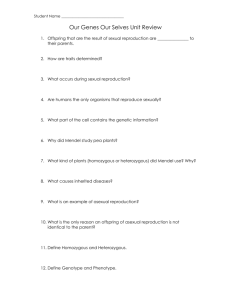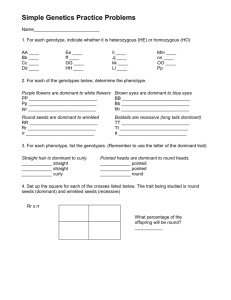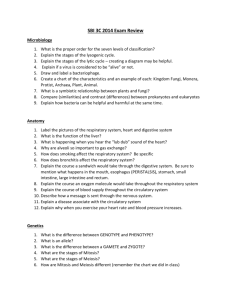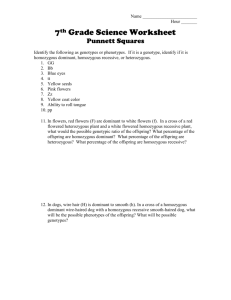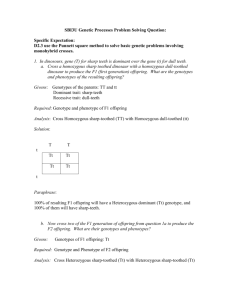Genetics Problems AP Biology MONOHYBRID CROSSES I
advertisement
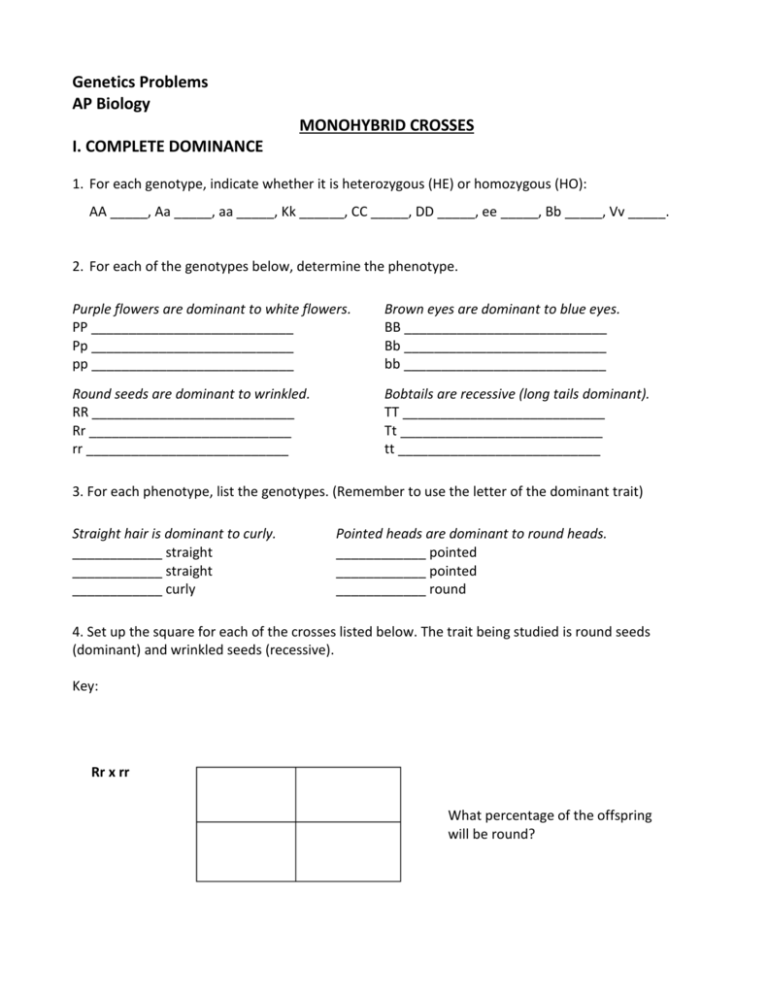
Genetics Problems AP Biology MONOHYBRID CROSSES I. COMPLETE DOMINANCE 1. For each genotype, indicate whether it is heterozygous (HE) or homozygous (HO): AA _____, Aa _____, aa _____, Kk ______, CC _____, DD _____, ee _____, Bb _____, Vv _____. 2. For each of the genotypes below, determine the phenotype. Purple flowers are dominant to white flowers. PP ___________________________ Pp ___________________________ pp ___________________________ Brown eyes are dominant to blue eyes. BB ___________________________ Bb ___________________________ bb ___________________________ Round seeds are dominant to wrinkled. RR ___________________________ Rr ___________________________ rr ___________________________ Bobtails are recessive (long tails dominant). TT ___________________________ Tt ___________________________ tt ___________________________ 3. For each phenotype, list the genotypes. (Remember to use the letter of the dominant trait) Straight hair is dominant to curly. ____________ straight ____________ straight ____________ curly Pointed heads are dominant to round heads. ____________ pointed ____________ pointed ____________ round 4. Set up the square for each of the crosses listed below. The trait being studied is round seeds (dominant) and wrinkled seeds (recessive). Key: Rr x rr What percentage of the offspring will be round? Rr x Rr What percentage of the offspring will be round? RR x Rr What percentage of the offspring will be round? More Complete Dominance Practice- show all work and remember to include keys! 5. A homozygous dominant tall plant is crossed with a short plant. What percentage of the offspring will be tall? 6. In guinea pigs, the allele for short hair is dominant. Show the cross for two heterozygous guinea pigs. What percentage of offspring will have short hair? 7. In pea plants, purple flowers are dominant to white flowers. If two white flowered plants cross, what percentage of their offspring will be white flowered? 8. A testcross is used to determine if the organism showing a dominant trait is homozygous or heterozygous. For example, if two purple heterozygous flowers crossed and produced a purple offspring, a test cross would determine whether the purple offspring was also heterozygous or whether it was homozygous dominant. What test cross results would you expect if the purple offspring was heterozygous? What results would you expect if the purple offspring was homozygous dominant? Show your work! Remember that in a testcross, the individual of the unsure genotype is crossed with the recessive individual. II. INCOMPLETE DOMINANCE ANDULASIAN CHICKENS Inheritance of feather color in Andulasian chickens follows the pattern of incomplete dominance. Black Andalusian chickens have BB genes, white Andalusian chickens have WW genes and blue Andalusian chickens have BW genes for feather color. Key: 9. Determine the possible genotypes and phenotypes of offspring of one black and one white Andalusian chicken. 10. Determine the possible genotypes and phenotypes of offspring of two blue Andalusian chickens. 11. Determine the possible genotypes and phenotypes of offspring of one blue and one white Andalusian chicken. FOUR O’CLOCK COLOR Petal color of four o’clock flowers is inherited by incomplete dominance. Plants with RR genes have red flowers. Plants with WW genes have white flowers. Plants with RW genes have pink flowers. Key: 12. Sarah planted four o’clock in her garden. All the seeds came from one set of parent plants. When the flowers bloomed, Sarah saw that all her flowers were pink. What were the genes of the parent plants? Show your reasoning. 13. Matthew also planted four o’clock. All of his seeds came from one set of parents. When his plants bloomed, 50% were white and 50% were pink. What were the genes of the parent plants? Show your reasoning. 14. When Sarah went to plant her garden the following year, she decided that she wanted more colors of four o’clock than just pink. She decided that she wanted 25% red flowers, 25% white flowers and 50% pink flowers. What genes must the parents plants have to produce offspring in these percentages? Show your reasoning. III. CODOMINANCE Inheritance of cattle coat color follows the pattern of codominance. Red shorthorn cattle have RR genes, white shorthorn cattle have WW genes, and roan have RW genes. Key: 15. Determine the possible genotypes and phenotypes of offspring of one red parent and one roan parent. 16. Determine the possible genotypes and phenotypes of two roan parents. 17. Determine the possible genotypes and phenotypes of one red parent and one white parent. IV. MULTIPLE ALLELES 18. Mario is surprised to learn that although his both parents are blood type A, he is blood type O. What must his parents’ genotypes be? Prove your answer with a cross. 19. In a paternity case, both child and mother are blood type AB. What type of blood would definitely prove that the man is not the father of this child? 20. Mr. Metcalf, a hospital director calls you in a state of shock. When he has finally calmed down enough to talk coherently, you learn that one of his nurses came on duty the previous night after spending a few hours with his friends at a local bar, and as a joke proceeded to exchange wrist bands on the four babies in the nursery, all of whom are indistinguishable. As a first step in unraveling this mess, you blood type the parents and babies, with the exception of Mr. and Mrs. Blatz who refuse to do anything until they have talked with their lawyer. The results of the parents' blood tests are: Mrs. Frink – AB, Mr. Frink - O Mrs. Zeeb – B, Mr. Zeeb - B Mrs. Youngblood – O, Mr. Youngblood O Mrs. Blatz and Mr. Blatz – not typed Assume that the individuals listed are the true parents, each set of parents having had one of the four babies. Indicate the one family to which each of the following children belongs on the basis of blood type. Prove your answers with crosses. Hint: you will need more than one cross for the Zeebs. Baby 1 - B Baby 2 - A Baby 3 - AB Baby 4 - O Parents of baby 1? Parents of baby 2? Parents of baby 3? Parents of baby 4? V. SEX-LINKED INHERITANCE 21. Green-red colorblindness is a sex-linked disease. If a woman that is a carrier marries a normal male, what percentage of their male children will be colorblind? What about the female children? Remember to start with a key. 22. If a colorblind male marries a normal female, what percentage of their sons will be colorblind? What percentage of their daughters will be colorblind? DIHYBRID CROSSES 23. In guinea pigs, black hair is dominant to brown hair and short hair is dominant to long hair. What would be the genotypes of the following? a. A black, long haired variety, homozygous for both traits? b. A brown, short haired variety, heterozygous for hair length? c. A brown, long haired variety? 24. In summer squash, white fruit color (W) is dominant over yellow fruit color (w) and disk-shaped fruit (D) is dominant over sphere-shaped fruit (d). If a homozygous white, homozygous disk-shaped fruit is crossed with a yellow, sphere-shaped fruit, what will the phenotypic and genotypic ratios be for: a. the F1 generation? b. the F2 generation? ANALYZING PEDIGREES 25. Tay-Sachs disease is a fatal genetic disorder caused by a recessive allele. The pedigree chart below shows the history of the disease in a family. Identify the possible genotype(s) of each member of the family. Key: = Normal male = Tay-Sachs male = Normal female = Tay-Sachs female 26. Create a pedigree for you family. You will be supplied with PTC paper which contains the chemical phenylthiocarbamide which has a bitter taste to most people. (The ability to taste the chemical is the dominant trait). Test as many family members as you can: try to test siblings, parents, grandparents, aunts, uncles, and cousins. The more members you test, the easier it will be to set up your pedigree. After you draw the pedigree, determine possible genotype(s) of each family member.

